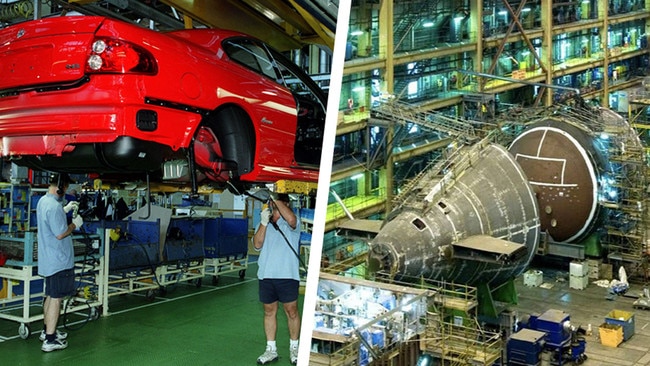Thought SA’s car industry was important? Our nuclear subs will blow it out of the water
For decades, car manufacturing was one of SA’s most important industries – but the nuclear submarines program will dwarf its impact on the economy, jobs, pay and skills.
SA News
Don't miss out on the headlines from SA News. Followed categories will be added to My News.
Building nuclear-powered submarines in Adelaide will outstrip the shuttered car industry in job numbers, pay, skills and contribution to the state economy, says Premier Peter Malinauskas.
In an interview with The Advertiser, Mr Malinauskas said both the quantum and quality of submarine work would outweigh the defunct car manufacturing industry – up to 5500 Adelaide shipyard jobs versus Holden’s 944 when the Elizabeth plant closed in 2017.
Up to 4000 workers will be employed to design and build the submarine construction infrastructure at Osborne Naval Shipyard, in Adelaide’s northwestern suburbs.
A further 4000 to 5500 direct shipyard jobs are expected to be created to build nuclear submarines when the program reaches its peak, along with an estimated 20,000 jobs nationally in the next 30 years.
Both Mr Malinauskas and Prime Minister Anthony Albanese have likened the nuclear submarine enterprise to the post-war Australian car industry, creating jobs, security and economic spin-offs for communities for decades.
But Adelaide University analysis prepared in 2015 shows the car industry generated $29bn to national GDP, while the project to build at least eight nuclear-powered submarines in Adelaide is estimated to be worth between $268bn and $368bn and include a $30bn investment into Australia’s industrial base.
Asked to explain why the Adelaide submarine construction’s economic value went beyond the car industry, Mr Malinauskas said the skill levels from production to engineering would require complex nuclear standards.
“The first thing is, there’s both quantum and quality. Numerically, this is going to require a lot more people than what the car industry required in South Australia,” he said.
“Up to 5500 direct jobs alone – it’s five times what Holden had at its closure. So, just the raw number of people working on this is going to be greater than what was working on the car industry in South Australia.
“But then there is the complexity, the skill level required for the work. We will need everything from basic production workers with the sort of skills that were consummate to the car industry, but then it works up pretty aggressively from there – everything from computer engineering, nuclear skills – these are infinitely more complex in their nature.
“The other thing is that even at a trade level: doing electrical work requires a nuclear standard, doing gasfitting work requires a nuclear standard, welding requires a nuclear standard – so everything is a step up in grade in terms of qualification requirements.
“The virtue of that is the higher the skills, the higher the working conditions that come with that. That is to the benefit of the South Australian economy more broadly, and also prospective employers more broadly, as long as we are doing the work of workforce development.
“I think the biggest risk to all of this is workforce development but the benefit of it is a lot more people doing more skilled work, which brings higher remuneration and greater job security, which ticks every box.”
Australian Industry and Defence Network chief executive officer Brent Clark said nuclear specialist workers would be able to “write their own ticket” in terms of salary, while pay would range from about $80,000 for unskilled manual labourers to up to $250,000 for the highly skilled workforce.

Adelaide University research published in 2013 found Holden’s Elizabeth manufacturing plant was directly employing 1750 people, down from 2700 in 2011.
The total economic activity linked to Holden’s Elizabeth operations in 2011 included a $1.1bn contribution to gross state product, or 1.3 per cent of GSP, 11,700 jobs, or 1.5 per cent of employment and a $65m annual contribution to state taxation base.
Mr Clark – previously the interim chief and Australian program director of the French firm that spearheaded the scrapped Attack Class submarine project – said numerous studies showed every dollar spent on the nuclear submarines would have a multiplier of between $1 and $2.50.
“Given that the government is expecting a spend of $368bn over the life of the program, the more expenditure domestically, the greater return to the Australian taxpayer and, hence, a greater economic benefit. Whilst not all of the domestic expenditure will be in SA, it is a simple fact that a high percentage will be,” he said.





